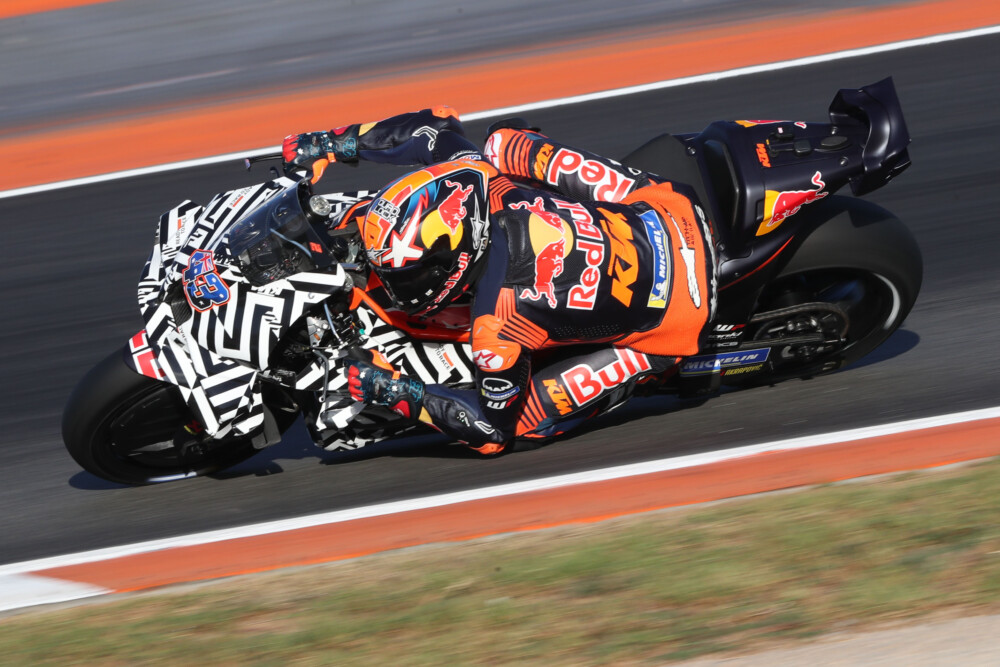Cycle News In The Paddock
COLUMN
Carbon-Fiber-Black Art With a Checkered History
It’s encouraging to think that racing is an important tool for research and development—a place where motorcycle design is advanced. Just as warfare accelerates technological progress.
Sadly, it’s only marginally true. This worthy aspect has always been hostage to regulations, and never more so than with today’s dumbing down into cost-saving conformity, where not even cylinder bore size is free.

Perhaps this is why advances in recent decades have been confined to minor (although not unimportant) aerodynamic tweaks and active ride-height adjustment.
The year 2023, however, did see something fundamental. KTM’s carbon-fiber chassis—though this could hardly be called an innovation since the material was first used in the 1980s. It gained little momentum, then fell out of favor, for probably all the wrong reasons—that in racing, convention succeeds better than invention. Copy but improve.
Early non-metallic efforts came from Britain. Notably from the then-independent Suzuki team, in a spell when the factory had taken a step back. They were thrown on their own resources to try to keep the obsolescent square-four RG motor competitive.
Step forward, innovative designer Nigel Leaper and the then new honeycomb-sandwich board, developed for the aircraft industry (for such things as inner walls and tray tables) and eagerly adopted by the racing-car world.
Leaper devised a folded and bonded chassis to contain the square-four engine, immediately nicknamed “cardboard box.” Ridden by, among others, Niall Mackenzie and Rob McElnea, who described the ride as “plush” while mechanics found it to be crash-proof almost to the point of indestructibility. Both achieved top-10 finishes against full-factory Honda and Yamaha opposition.
Leaper designed an autoclaved full-carbon Mk2 for the V4 that the factory produced for the following year, but the “not invented here” syndrome saw Suzuki shuffle it off to the back shelf in favor of their own conventional aluminum-tube chassis.
Mackenzie had prior experience on another British effort, the 250 Armstrong. This used a molded carbon-fiber spine, filled with expanded foam and baked in an autoclave oven, also standard racing-car practice at the time. The Rotax-powered bikes, the brainchild of Mike Eatough, also had carbon-fiber swingarms. And they performed well, with Donnie McLeod, on the podium in Belgium in 1986,
A low-budget independent effort by British designer Chris Wheatley appeared briefly in 1986, ridden by Gary Lingham, but sank without trace.
The aim back then was for total chassis stiffness, to let the well-controlled suspension absorb the bumps. Chassis flex was blamed, correctly enough, for all sorts of wayward handling.
Convention took over, while chassis design itself moved on. Maximum stiffness, it turned out, was not ideal. At the increasingly high lean angles allowed by tire and suspension development, too much stiffness encouraged what Wayne Rainey in the early 1990s dubbed “chatter-bounce,” and it was only when he switched from the too-stiff factory chassis to a more flexible Harris version that the problem was reduced.
But if maximum stiffness wasn’t right, nor was random flip-flop flexibility. A chassis needed to be rigid fore-and-aft, to absorb braking loads (also increasing, along with better tires and carbon discs) but to flex in the right way laterally, to absorb bumps at full lean, thus avoiding chatter.
It sounds simple, but it is far from it. The quest for a chassis that will “bend like a tree,” to borrow one Japanese engineer’s phrase, remains as absorbing and difficult today as it always was. Much progress has been made, all with aluminum (and for KTM, steel-tube) chassis, with carbon thought to be too stiff. But like money, in racing, more is good but is never enough.
There was, however, one believer that carbon-fiber, far superior strength-to-weight, could be made to work. Ducati Corse’s first MotoGP engineer Filippo Preziosi’s innovative style, saw him make a minimalist carbon-fiber box that combined the function of an airbox and main chassis spar. Isn’t carbon too stiff? We asked him. No, he insisted. The material is not important in itself, it is how you use it.
His experiments were not successful, however, underlined by Rossi’s failure to continue Casey Stoner’s successes with the Desmo. Preziosi eventually paid the price, replaced in 2013 by current Ducati genius innovator Gigi Dall’Igna, whose prowess has been rewarded with the marque’s current domination.
The first thing he did was to revert to a full aluminum chassis, but was Preziosi so wrong?
Stoner recently came to his defense in an interview with Italy’s Gazzetta dello Sport, saying that it was lack of budget that constrained chassis development. Preziosi was “very clever” but didn’t have the resources to develop his ideas. Ducati’s big mistake, said the Australian, was failing to support him.
While carbon-fiber swingarms are common, KTM is the latest and currently the only constructor to delve into the black arts of carbon chassis construction. Has bike racing finally caught up to F1? CN
Click here to read the In The Paddock Column in the Cycle News Digital Edition Magazine.
Click here for all the latest MotoGP news.
